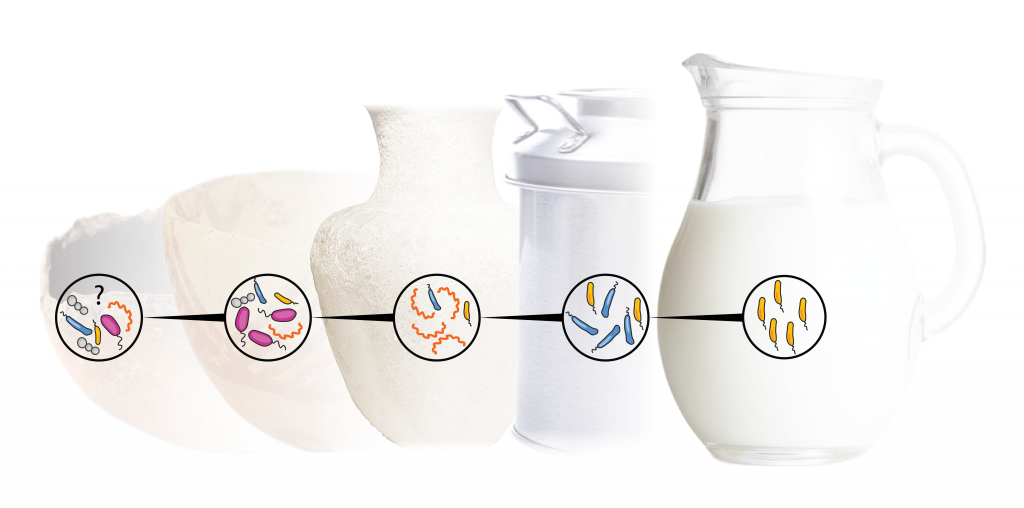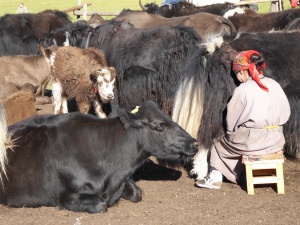
Heirloom Microbes
Microbes are an integral part of our cuisine, and are especially integral to dairy products. In this project we are combining archaeology, microbiology, food science, and cultural anthropology, in order to gain substantial insight into dairying practices, microbial diversity, and the impact that microbes have had on our foods, our biology, and our society today.
Within and beyond the human body, human cultures enable microbial ecosystems to grow and thrive. In our cuisine, nowhere is this more obvious than in the creation of dairy products, which have enormous global complexity and diversity in taste, aroma  and texture. Thousands of years ago, with the invention of products such as yoghurts and cheeses, people were domesticating and manipulating microbes before they even knew of their existence. However, current microbial strains involved in food fermentation are highly regulated in order to maintain hygiene standards and reproducibility. We remain unaware of the vast microbial diversity involved in ancient food preparation, and the impact this microbial diversity would have had on flavours and textures. Additionally, as a result of contemporary food globalisation and industrialisation, traditional methods of dairying and their unique microbial cultures (such as yoghurt strains passed down through generations) are being lost at an alarming pace.
and texture. Thousands of years ago, with the invention of products such as yoghurts and cheeses, people were domesticating and manipulating microbes before they even knew of their existence. However, current microbial strains involved in food fermentation are highly regulated in order to maintain hygiene standards and reproducibility. We remain unaware of the vast microbial diversity involved in ancient food preparation, and the impact this microbial diversity would have had on flavours and textures. Additionally, as a result of contemporary food globalisation and industrialisation, traditional methods of dairying and their unique microbial cultures (such as yoghurt strains passed down through generations) are being lost at an alarming pace.
In the face of this ‘microbial extinction’ we will characterise the bacterial strains present in traditionally manufactured dairy products, enabling their genetic identification and, where possible, their deposition in microbial culture banks to remain available in perpetuity. We will explore three regions where dairying is an integral part of cuisine but is highly distinctive: Europe, the Middle East, and Central Asia.
 Given that dairying has taken place in these regions for hundreds, and perhaps thousands, of years, we will then turn our attention to the ancient past. The adoption of dairy foods into the adult diet, and the evolution of lactase persistence (the genetic ability to drink milk in adulthood), is one of the clearest examples of how genes and culture interact. Despite this importance, how this evolution happened is not well understood, although we know that milk must have been heavily processed in order to avoid producing the symptoms of lactose intolerance to become instead a digestible, nutritious food – with microbes likely playing a key role. We will use recent advances in archaeological science (the analysis of ancient proteins and DNA) to identify traces of dairy products in antiquity on pots and in tooth tartar (dental calculus), in order to understand how and why these products were powerful enough to shape both the human genome and millennia of human culture.
Given that dairying has taken place in these regions for hundreds, and perhaps thousands, of years, we will then turn our attention to the ancient past. The adoption of dairy foods into the adult diet, and the evolution of lactase persistence (the genetic ability to drink milk in adulthood), is one of the clearest examples of how genes and culture interact. Despite this importance, how this evolution happened is not well understood, although we know that milk must have been heavily processed in order to avoid producing the symptoms of lactose intolerance to become instead a digestible, nutritious food – with microbes likely playing a key role. We will use recent advances in archaeological science (the analysis of ancient proteins and DNA) to identify traces of dairy products in antiquity on pots and in tooth tartar (dental calculus), in order to understand how and why these products were powerful enough to shape both the human genome and millennia of human culture.
In combining archaeology, microbiology, food science, and cultural anthropology, we will gain substantial insight into dairying practices, microbial diversity, and the impact that microbes have had on our foods, our biology, and our society today.
 Related Publications
Related Publications
Hendy J, Rest M, Reichhardt B, Aldenderfer M, Warinner C. Cultures of Fermentation: Living with Microbes. Current Anthropology 62, supplement 24.
Reichhardt B, Enkh-Amgalan Z, Warinner C, Rest M. (2021) Photo Essay: Enduring Cycles – Documenting dairying in Mongolia and the Alps. In press at Current Anthropology 62, supplement 24.
Reichhardt B. (2021) Pastoral dairying in rural Mongolia: microbes as heritage. Archaeology of Food and Foodways 1.1. DOI: 10.1558/aff.15577
Hendy J (2016). Archaeological Detection. In Oxford Companion to Cheese. Oxford University Press. ISBN 9780199330881
Hendy J, Bickle P, Copper M, Charlton S. (2016) Neolithic cheese making: experimental archaeology and public engagement with replica vessels. PAST: The Newsletter of the Prehistoric Society. Nov. 2016
Warinner, Christina, Jessica Hendy, C. Speller, E. Cappellini, R. Fischer, C. Trachsel, J. Arneborg, N. Lynnerup, O.E. Craig, D.M. Swallow, A. Forakis, R.J. Christensen, J.V. Olsen, A. Leibert, N. Montalva, S. Fiddyment, S. Charlton, M. Mackie, A. Canci, A. Bouwman, F. Rühli, M.T.P. Gilbert, and M.J. Collins. 2014 Direct Evidence of Milk Consumption from Ancient Human Dental Calculus. Scientific Reports 7(7104).
 Resources
Resources
During our ethnographic fieldwork in 2017, we learned that one of the things dairy pastoralists today were most curious about was how other dairy pastoralists lived and which products they made. To help show how dairying is practiced around the world, we created this photobook. Learn about the daily life, culinary practices, and diverse foods made by dairy pastoralists in the Alps (Austria and Switzerland), the Near East (Jordan), and Inner Asia (Mongolia) in this photobook.
Social Media
Visit our Heirloom Microbes Facebook page!
Philanthropy
 This project, in partnership with Charlotte Vad of the Khovsgol Dairy Project, works to support Sarlagiin Saikhan Khishig, a cooperative of traditional nomadic dairy pastoralists in the Khovsgol Nuur region of northern Mongolia.
This project, in partnership with Charlotte Vad of the Khovsgol Dairy Project, works to support Sarlagiin Saikhan Khishig, a cooperative of traditional nomadic dairy pastoralists in the Khovsgol Nuur region of northern Mongolia.